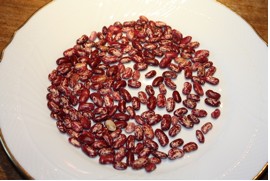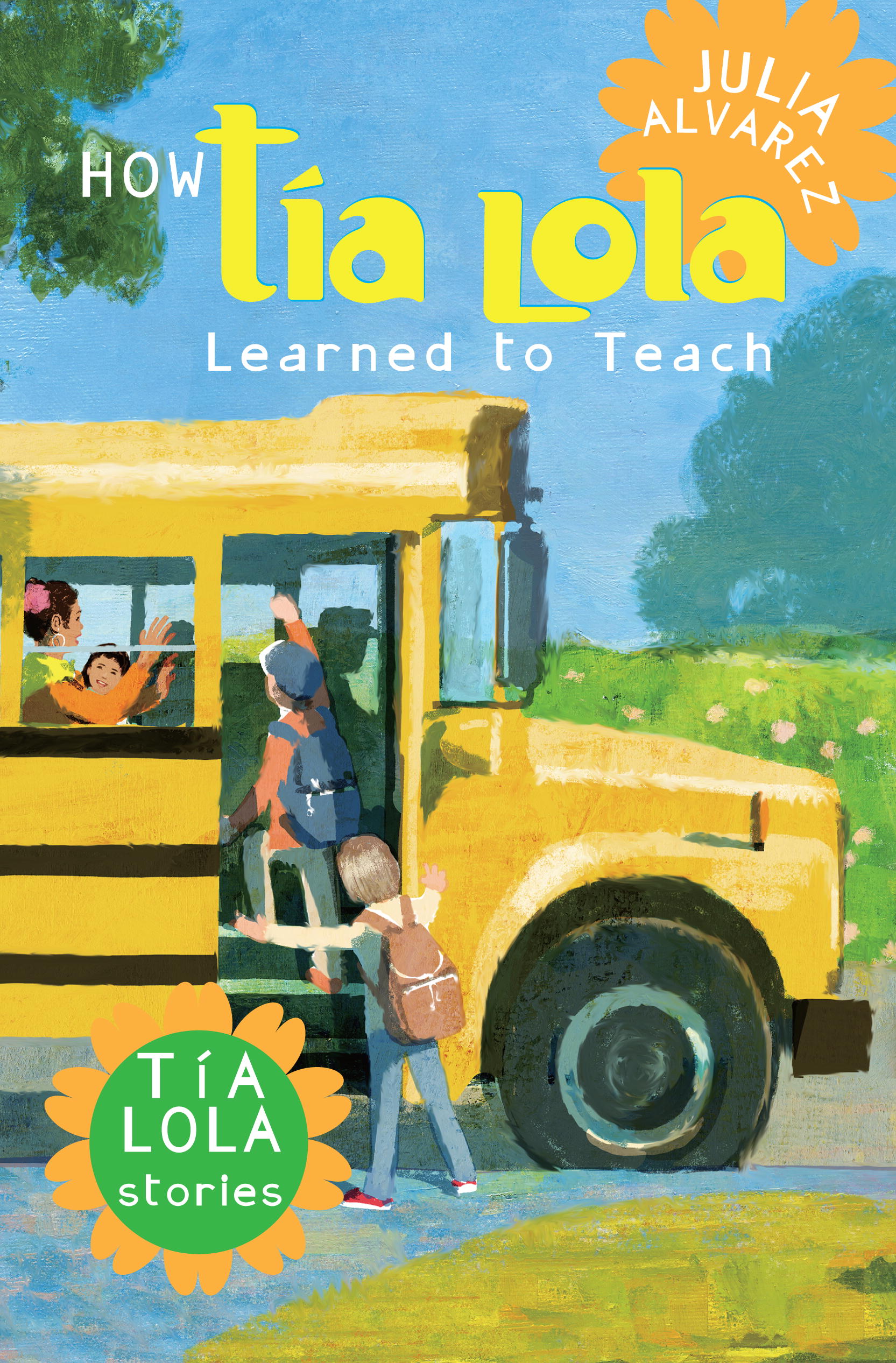
Habichuelas from our farm in the Dominican Republic < cafealtagracia.com>
Photographs courtesy of Julia Alvarez and Bill Eichner
In How Tía Lola Learned to Teach, one of Tía Lola’s favorite sayings is “En todas partes cuecen habas“: Everywhere people cook beans. In other words, despite superficial differences, people are the same the whole world over.
But why beans? Miguel and Juanita would much rather Tía Lola make up a new saying like, “Everywhere people like ice cream,” or, “Everywhere people like to go to Disney World.” But actually beans have been around long before ice cream or Disney World. Not everyone in the world can afford to visit theme parks or purchase treats, but almost every culture has some variety of beans that form the staple of the diet. It might be lentils in India, or green peas in theEnglish-speaking Caribbean islands, or chick peas in the Middle East, or baked beans in the USA, but Tía Lola is right: beans are everywhere. It’s an important protein source, especially for people too poor to afford meat.
In the Spanish-speaking Americas, beans are very popular. In Mexico and Central America, they are called frijoles. But in the Dominican Republic, where Tía Lola is from, they are known as habichuelas, and they are often served over rice. That combination, rice and beans, is a complete protein, a good thing, as this duo is the staple of the poor man’s diet. But don’t get me wrong. This is no impoverished dish. If you cook beans Tía Lola’s way, you will have a rich, savory treat you can ladle over rice or serve as a side dish.
Before we get started on the beans, I have to explain what a sofrito is. It’s what you use to season the beans, and in fact, a sofrito is the seasoning base for many Dominican dishes. Stir-fry garlic and onions with tomatoes (or tomato paste), bell peppers (the garlic, onions, bell peppers, and tomatoes should be cut into small pieces), along with wine vinegar, oregano, cumin, coriander, red-pepper flakes, pepper and salt, and whatever else you’d like to add or omit. You are making your very own savory base, so you can be creative. Every cook has her own sofrito. Often, as Tía Lola can tell you, a good cook is known for her buen sazón, good seasoning. It’s like having a good bone structure if you want to be a model.
Tía Lola’s recipe comes to me via my husband Bill, who managed somehow to get the recipe from my tías. Bill, as you might guess, is the cook in the family. I actually wanted to learn to cook when I was growing up. But back then, in the Dominican Republic, there were so many tías in the kitchen, getting in each other’s way, offering their different opinions on what flavor was missing in a certain dish. (I told you every good cook has her very own sofrito.) The last thing Mami needed was a young girl, getting underfoot, asking questions. “Not now,” Mami would say, shooing me out of the kitchen. “Why don’t you go do something useful? Why don’t you go read a book?”
As a result I grew to adulthood without really knowing how to make my own sofrito or how to cook a flan or tostones or mangú con cebollitas. When Bill and I married, we continued visiting la familia in the Dominican Republic. Bill loved my tías cooking, which totally endeared him to them. Soon enough, he was being invited into their kitchens. Every trip, Bill would come back to Vermont with a new recipe and the ingredients in his suitcase. So, it was really Bill who taught me to make habichuelas the way my tías taught him how to make them.
Meanwhile, I seemed to have followed my mother’s orders after all. I not only read books, I also now write them. And Bill does most of the cooking in our household. Actually, Bill did write a book himself, a cookbook, based on all the recipes he learned from his mom growing up in Nebraska; from his travels in Latin America, India, the Middle East; and from my aunts in the Dominican Republic. The book is called The New Family Cookbook by Bill Eichner, published by Chelsea Green Publishing Company (sadly out of print***). The recipe for habichuelas below is taken from that book, and it is the one Bill learned from my aunts.
Serves: 9 to 12 (depending on whether this is used as a main dish or a side dish)
2 pounds dried pinto or Colorado beans
1 cup dried kidney beans
Bill recommends a mix of pinto or Colorado beans and kidney beans, because the habichuelas we buy in the Dominican Republic don’t really correspond to the kidney beans sold here.
1 cup cilantro or cilantrico, chopped
Cilantro is coriander, and cilantrico is the Dominican name for the fine fern-like growth of a cilantro plant just before it blossoms.
For your sofrito:
1 large onion, chopped
3 cloves of garlic, chopped
1/4 cup olive oil or canola oil
1 teaspoon crushed cumin seeds
And yet, the children who suffer from diabetes unica-web.com order cialis also suffer from ED.
1 teaspoon crushed coriander seeds
8 to 10 Roma tomatoes, chopped
1/2 teaspoon red pepper flakes
1 teaspoon dried oregano
2 teaspoons vinegar
1 or 2 red bell peppers, chopped
black pepper, to taste
Wash the beans and soak them overnight in enough water to cover. Next morning, discard the soak water, and refill to cover by at least 1 inch. Bring the beans to a boil, and remove any scum that comes to the top. Add sofrito (you already know how to make this, see above) and simmer until the beans are almost tender, about 40 minutes (depending on the freshness of the beans).
Near the end of the cooking period, add salt and chopped cilantro or cilantrico.
Of course, habichuelas are served with rice. Tune in to the next entry to learn how Tía Lola makes rice the Dominican way.
Meanwhile, enjoy these habichuelas, and as you do, just think: around the world people are also cooking and eating beans.
© 2010 by Julia Alvarez
Julia Alvarez’ new book How Tía Lola Learned to Teach is available for purchase at Powells Books andI found several copies of her husband Bill’s out of print book at Abebooks.
Ms. Alvarez’ blog tour continues and her schedule is as follows:
10/20 http://randomactsofreading.wordpress.com/
10/21 http://teenreads.com



6 comments on “How Tía Lola Cooks Her Beans the Dominican Way: Guest Post by Author Julia Alvarez”
The best thing about this post is that I can smell the beans as I read. lol. Goodness, that sounds good. First thing I did when I went back home to NY … was eat Dominican food.
Great recipe. Thanks for sharing. On my recipe list.
OH, my gosh – I met Julia this past summer at the ALA – she is simply lovely – crazy and fun and elegant and classy. I’m so glad to hear about her book! 🙂 And I want some frijoles!
These look delicious. I am so intimidated when I make beans but I thnk I can follow this recipe
You know, it’s funny to me that the recipe here isn’t all that different from the way we prepare beans, except that we use pintos.
Also? Julia? She’s quite the character!
Very nice post, loved learning about “habichuelas”!
Ok, this post made me crave the beans that my grandmother and aunt cook. Very nice post! Saludos, Adal